“Flowers of South-West Europe - a field guide” - de Oleg Polunin e B.E. Smythies
“Revisitas” de regiões esquecidas no tempo - “Plant Hunting Regions” - a partir de uma obra de grande valor para o especialista e amador de botânica como da Natureza em geral.
Por
Horst Engels, Cecilia Sousa, Luísa Diniz, Nicole Engels, José Saraiva, Victor Rito
da
Associação “Trilhos d’Esplendor”
2.13 The Northern Serras of Portugal
2.13 As Serras do Norte de Portugal
2.13.2 Serra da Estrela
|
Folha de Cálculo: Flora da Serra da Estrela
(Lista provisória de plantas vasculares e não-vasculares)
|
Mapas das Serras do Norte de Portugal:
|
2.13.2 Serra da Estrela - Ambientes rochosos
Vegetação rupícola no piso de baixa altitude na Serra da Estrela
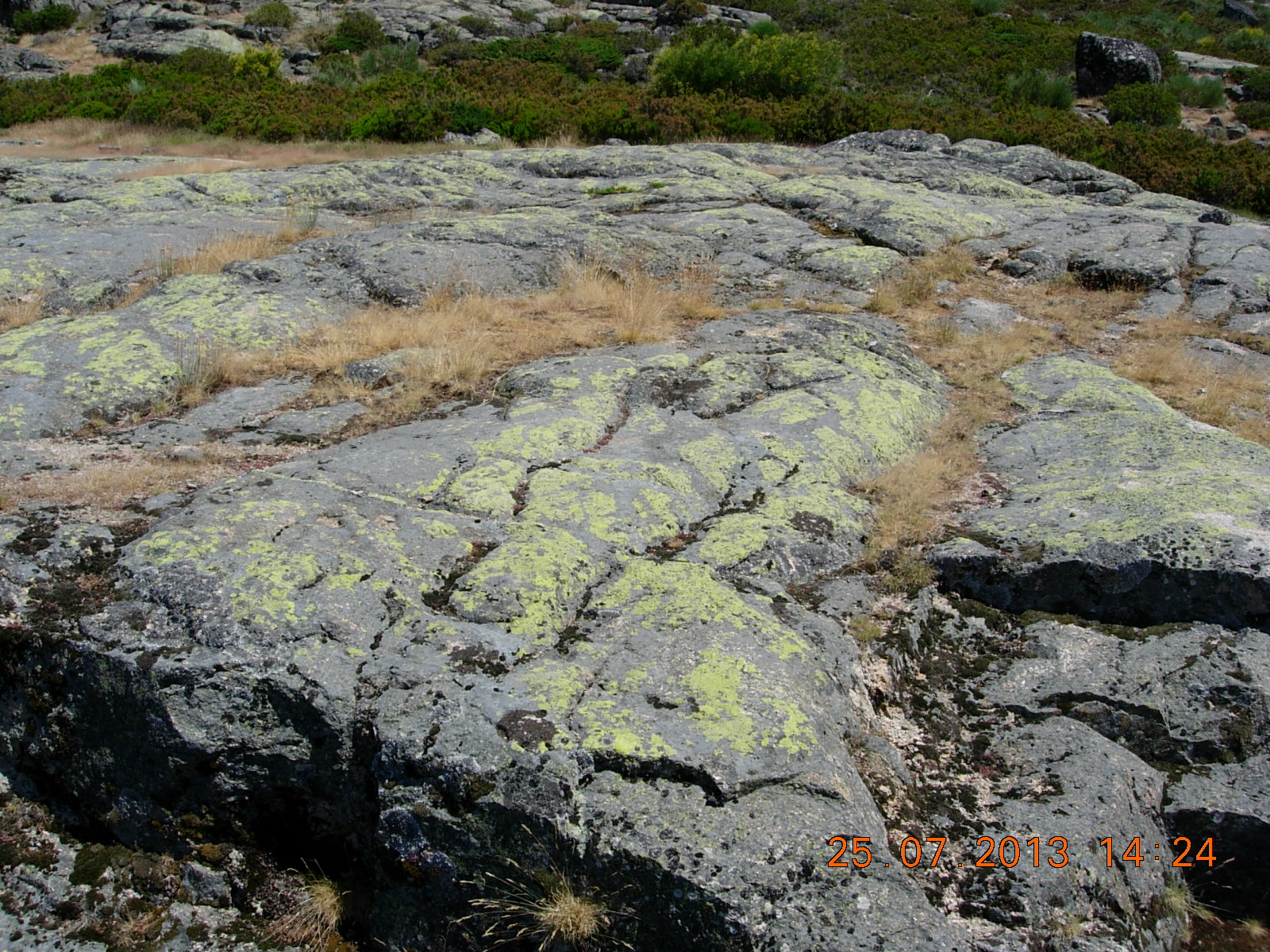
Liquens, musgos e gramíneas acima de granito no piso de média altitude na Serra da Estrela
Asplenium adiantum-nigrum perto da Lagoa Comprida, Serra da Estrela
Asplenium adiantum-nigrum perto da Lagoa Comprida, Serra da Estrela
Ambientes rochosos
Ambientes rochosos encontram-se sobretudo em duas paisagens diferentes, por um lado nas costeiras marítimas, e por outro lado nas serras. Nas serras dominam as rochas sobre os solos metereorizados e enriquecidos com humus, mais encontrados nas planícies.
Distinguem-se os seguintes habitats rochosos no âmbito da Rede Natura 2000 em Portugal:
8 Habitats rochosos e grutas
81 Depósitos de vertente rochosos
8130 [PDF 257 KB] Depósitos mediterrânicos ocidentais e termófilos
82 Vertentes rochosas com vegetação casmofítica
8210 [PDF 243 KB] Vertentes rochosas calcárias com vegetação casmofítica
8220 [PDF 242 KB] Vertentes rochosas siliciosas com vegetação casmofítica
8230 [PDF 285 KB] Rochas siliciosas com vegetação pioneira da Sedo-Scleranthion ou da Sedo albi-Veronicion dillenii
8240 [PDF 300 KB] *Lajes calcárias
83 Outros habitats rochosos
8310 [PDF 197 KB] Grutas não exploradas pelo turismo
8330 [PDF 261 KB] Grutas marinhas submersas ou semissubmersas
Para a Flora e Fauna da Serra da Estrela, com rochas predominantemente siliciósas, têm relevância os habitats das ‘cascalheiras’ (engl. screes) - depósitos mediterrânicos ocidentais e termófilos (habitat 8130pt2), das ‘vertentes rochosas siliciosas com vegetação casmofítica’ (habitat 8220), das ‘rochas siliciosas com vegetação ioneira da Sedo-Scleranthion ou da Sedo albi-Veronicion dillenii’ (habitat 8230pt2), como o habitat das grutas não exploradas pelo turismo (habitat 8310).
Jan Jansen (2002) caracteriza os ambientes rochosas da Serra da Estrela no “Geobotanical guide of the Serra da Estrela” (pp. 175-193) da seguinte forma:
Organisms living attached to rocks can obtain water only from direct precipitation, runoff or seepage. Organisms bound to atmospheric water should he able to cope with alternating interval s lading any water supply. All of them are poikilohygric, which means that they maintain life in a dormant state when totally deprived from water supply. Most of them should also be adapted to an extreme temperature regime, rock surfaces often being subjected to large temperature fluctuations within shorter or longer periods, intensifying water shortage in addition. In the upper belt temperature extremes on rock surfaces may vary from less than -10 °C to more than +50 ºC. Vascular plants cannot grow on merely bare rock surfaces, but some algae, bryophytes and especially many lichens are able to grow on them despite the extreme conditions. A lichen is the symbiotic association of a fungus and an alga. A symbiosis is the interaction between two and more species that benefits at least one of them. Only certain fungi and algae can get together to form a lichen body. The alga uses sunlight to make sugars that will feed both fungus and alga. The fungus creates a body that can house both organisms. There are several types of lichens. Crust-like lichens adhere tightly to the rocks by their entire lower surface and some may even be embedded in the rock. Leaf-like lichens have a distinct upper and lower surface and are attached only by small root-like structures. Finally shrub-like lichens form pendulous strands or hollow stalks and are usually attached at the base. Most of the exposed rocks in the area are largely covered by lichens. The upper belt of the Estrela hosts some 250 lichen species, about slightly more than half of them being able to grow on bare rocks. These species may occur in various assemblages on rock surfaces in major rock environments such as cliffs, tors, screes, and rocky freshwater beddings. The lichen and bryophyte assemblages cannot he treated here. Moreover, most of them as yet have not been studied. Nearly all bryophytes and vascular plants need at least some fine earth layer, built up from fallen down particles or blown-in dust. Rupicolous or saxicolous species grow in rocky environments. Saxicolous comes from the latin 'saxum’ (rock) and 'colere' (to inhabit); rupicolous is a translation of ‘rupestris' (what lives on rocks). The species that grow on rock surfaces may be called chomophytes (detritus plants), those that grow in rock fissures chasmophytes (crevice plants). In practice a considerable number of rupicolous species may be found growing in both situations.
A tentative classification of species by biotope preference (“first choice biotopes") can be useful to get a better understanding of their optimal growth conditions. Here two main groups of rupicolous species are distinguished, namely one with preference for rocks (fissures, rock surfaces and rocky slopes), the other with preference for screes. (From: Jan Jansen, 2002, pp. 175-193).
1. Fissuras em rochas, superfícias rochosa e encostas com cascalheiras
Rock fissures, rock surfaces and talus slopes
In this section conspicuous rock specialists and their environment are rather globally described, as conditions can change over very short distances making distinction of particular communities rather arbitrary. Before these rock dwellers are described we mention that they often grow close to species characteristic of other biotopes. Elements of natural rupicolous vegetation can show up in man-made biotopes such as walls and road verges. Since these places are often enriched by nutrients many (sub-)nitrophilous species may join them and can become predominant. Moreover talus slopes and forest fringes often occur closely to each other and their plant populations may intermingle hampering a clear separation. In the same way many annual grassland species are capable of colonizing decomposed rock surfaces and crevices containing a minimum of earth layer.
Espécies rupícolas características na Serra da Estrela são:
Narcissus rupicola
| |
Silene x montistellensis
|
1.1 Lower belt
Along some valley slopes in the lower belt a rare fern community with Lanceolate spleenwort (Asplenium billotii) and Cheilanthes tinaei may occur in crevices of schistose parent rock outcrops. Cracks and fissures in the same type of parent rock, but usually at higher elevations, may yield small populations of Murbeckiella sousae, a member of the Cruciferae family. Exposed cliffs on slopes or outcrops near windswept ridges and summits seem to provide optimal conditions for this species, strictly endemic to Portugal. The species is protected by the European Union and listed on annex IV of the EU habitats Directive. Its range includes the lower and middle belts of a few mountains in Central- and North-Portugal, namely Serra da Lousã, Serra do Açor, Serra da Estrela, Serra da Freita, Serra do Alvão, and Serra do Marão. Murbeckiella boryi, a close relative, is within Portugal restricted to Estrela growing in the upper belt in granitic rock fissures. Besides its different habitat preferences, Murbeckiella sousae can be distinguished (amongst other morphological characters) by its smaller petals (3.5 - 4 mm) and its greyish-green leaves. Petals of Murbeckiella boryi measure 3-7 (8) mm and its leaves are dark green, Sunny outcrops, walls and rock debris originating either from granite or metasediment rock may host conspicuous species like Digitalis thapsi, Dianthus lusitanus, Rumex induratus and Phagnalon saxatile. All four species occur in the lower and middle belt, but Dianthus lusitanus is the only species mounting into the highest belt. This pink-flowered Iberian endemic is obviously capable to cope with large temperature extremes. In that environment Dianthus lusitanus may form mosaic like patterns with thorn-cushion scrub.
Less xeric rocky environments may be colonized by Silene acutifolia. This pink flowered rock dweller is relatively common in the middle bell, but also mounts into the highest zone and is there sometimes joined or replaced by Silene x montistellensis. Silene acutifolia colonizes both rock crevices and shallow skeletal soils derived from granites or meta-sediments. It seems to have higher nutrient demands than both smaller shaped Murbeckiella species. In the middle belt it may occur close to Murbeckiella sousae populations that are able to profit from smaller cracks, especially under overhanging outcrops. On steep cliffs in the upper belt it may grow in wider fissures next to smaller cracks with Murbeckiella boryi, Silene acutifolia may be confused with Silene foetida with which it also hybridises. However S. acutifolia grows in rock fissures and S. foetida in screes. They can be morphologically distinguished as follows: S. acutifolia has a basal leaf rosette, an erect stem, and entire or almost entire pinkish purple petals: S. foetida has no basal leaf rosette, a stem that lies loosely along the ground surface, and deeply notched pale pink or white petals. Stem and leaf rosette of the hybrid S. x montistellensis are similar to S. foetida, its petals are less deeply notched, but the colour of the petals is similar to S. acutifolia. S. foetida and the hybrid are restricted to the Estrela. S. acutifolia has a West-Iberian distribution pattern including mountain areas in Alto Alentejo, all Beira provinces, Douro Littoral, Minho, and Tras-os-Mont es in Portugal. and Orense and Lugo in Spain.
1.2 Lower and middle belt
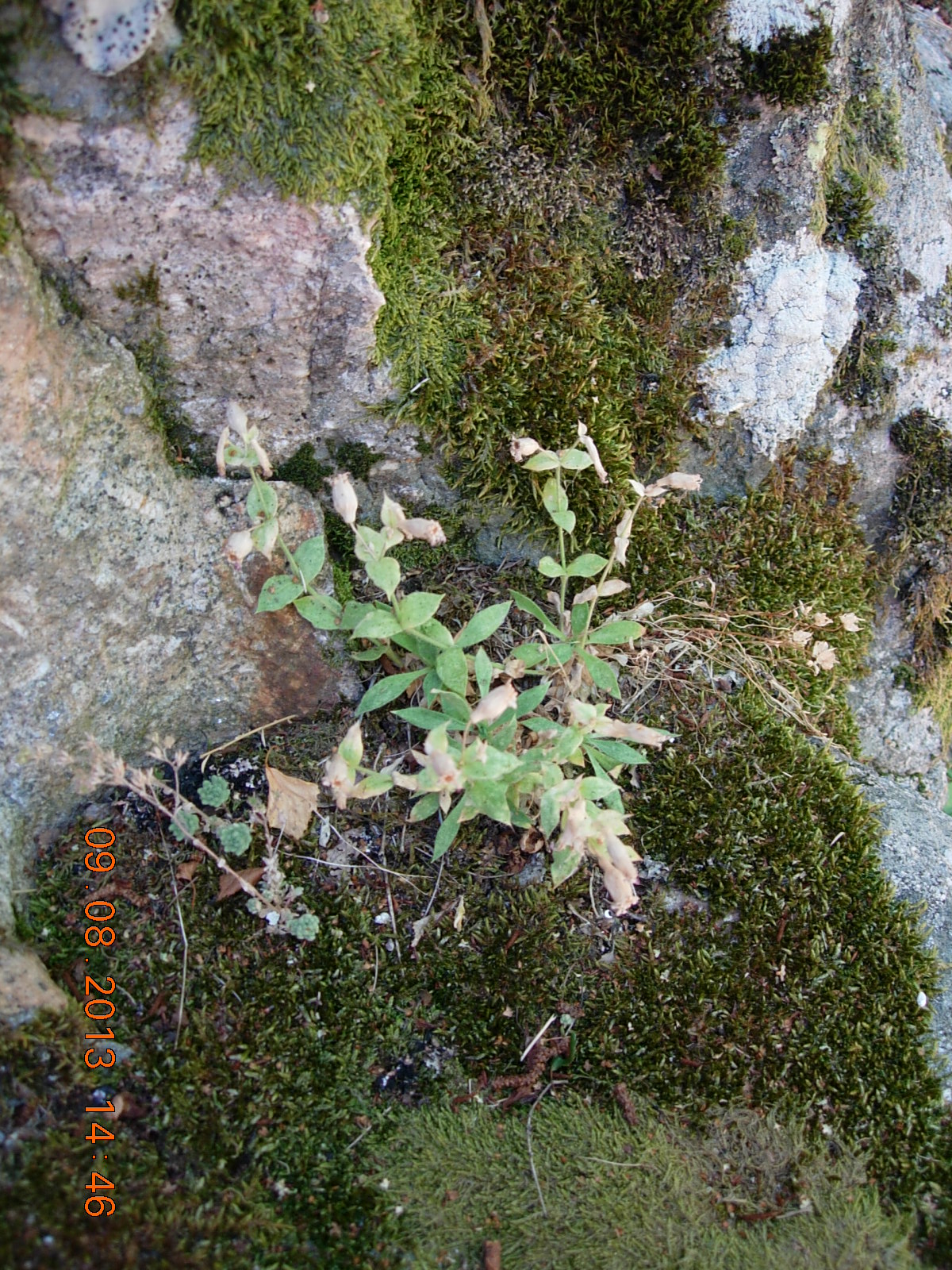
Silene ?acutifolia, Covão da Ametade (Serra da Estrela)
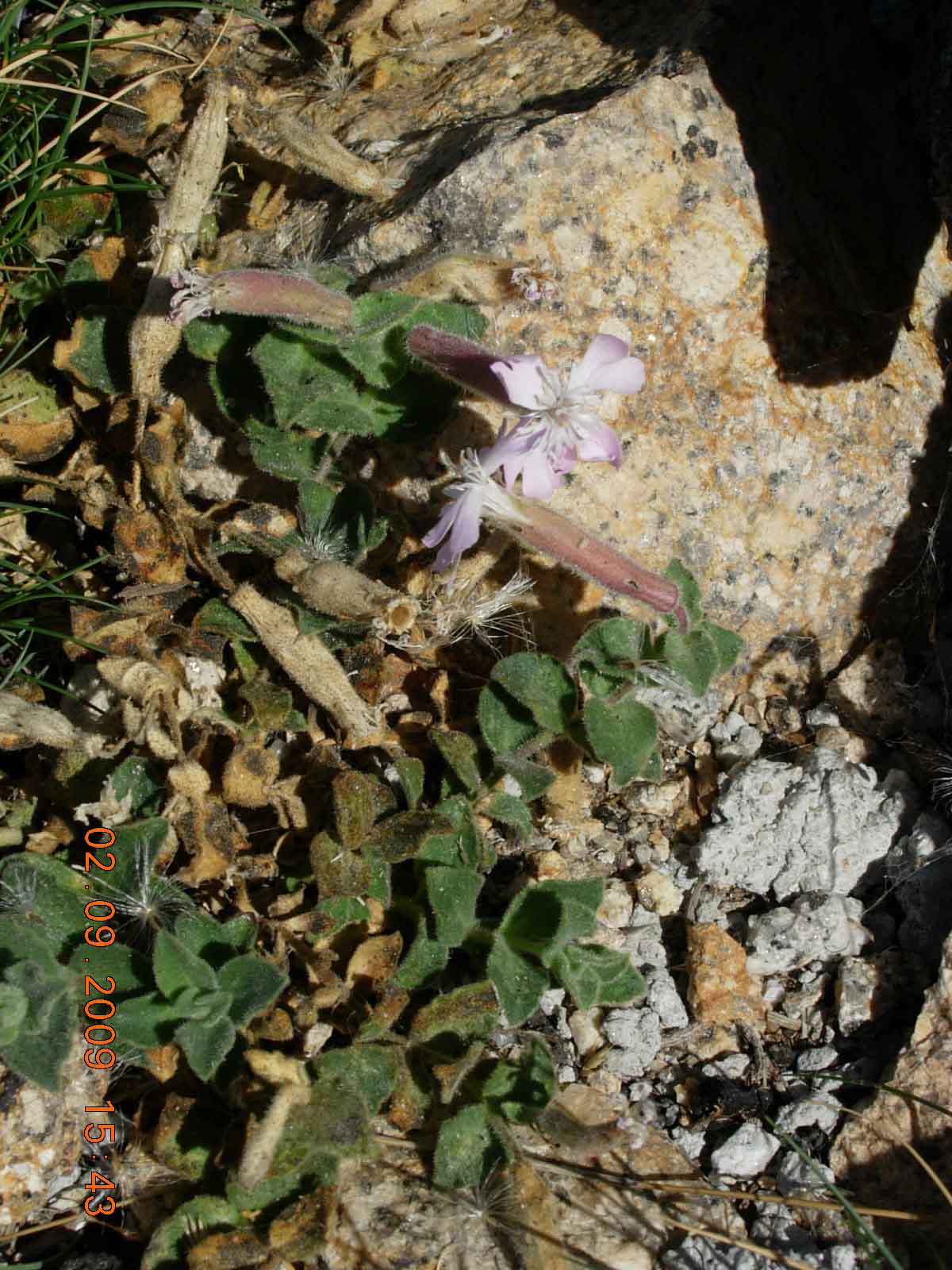
Silene foetida, perto do Cântaro Raso (Serra da Estrela), nas bermas da Estrada Nacional.
In the lower and middle belt. especially in the eastern Park areas with a decreasing Atlantic climate, but perhaps under locally more humid growing conditions, Silene acutifolia may he replaced by Saxifraga fragosoi vegetation. The range of Saxifraga fragosoi stretches less fur in western and southern, but further in northern and eastern direction including the Portuguese provinces of Beira Alta, Beira Baixa, and Tras-os-Montes and a major part of the northern Spanish provinces nearly reaching the Pyrenees. Outside the Iberian Peninsula it grows in mountains of southern France. The white-flowered carpets of Saxifraga fragosoi can be seen from late spring to early summer, especially on relatively steep rocky slopes mostly with exposures varying from north-west to north-east. After that period the sun-blaked carpets may draw attention by their reddish colour.
Saxifraga fragosoi - tapetes no Covão da Ametade, Serra da Estrela
Saxifraga fragosoi - Covão da Ametade, Serra da Estrela
Saxifraga fragosoi - Covão da Ametade, Serra da Estrela
Saxifraga fragosoi vegetation may occur in the lower belt, but reaches optimal development in the middle belt. Here it occupies shallow skeletal soils and may cover rock surfaces (granite, meta-sediment) often next to different plant assemblages from deeper soils, such as forests fringes, scrub formations and grasslands. Saxifraga fragosoi is frequently joined by Phalacrocarpum oppositifolium, Sedum hirsutum, and Sedum brevifolium. Occasionally other stone crops occur like Sedum anglicum subsp. pyrenaicum, Sedum forsterianum, and Sedum pruinatum.
Stonecrop (Sedum) is a genus of the Stonecrop family (Crassulaceae). Members of this family possess CAM metabolism.This is a photosynthetic strategy characteristic of succulents, in which C02 is chemically " fixed" at night and released during the day when stomatal pores remain closed. Thereby preserving internal moisture. This mechanism is an excellent adaptation to xeric biotopes such as rocks. Most Stonecrop species seem to develop optimally on flat or gently sloped substrates and frequently join other formations, such as grasslands and scrub, albeit in small numbers.
In the lower and middle belt Sedum pruinatum may form mats on gently sloped screes beneath steeper cliffs that are partly dressed with Murbeckiella sousae and Silene acutifolia vegetation. Sedum pruinatum is an another West-Iberian endemic taxon from rocky environments. It is absent in the provinces of Alto Alentejo, Beira Litoral and Luso, but elsewhere its range is similar to that of Silene acutifolia. The yellow-flowered Sedum pruinatum is able to weave loosely twined braids on gently sloped rocks and poorly developed soils, often at exposed and north-oriented sites. Both on meta-sediments and granites it is often joined by species that are characteristic for open grasslands or low scrub. The stands of the Estrela are more often joined by orophytes than Sedum pruinatum assemblages from North-Portugal and Galicia.
In the Estrela at least three annual Stonecrop species occur. Because of their Iifeform they are often considered character-species of therophytic formations; Sedum arenarium and Sedum pedicellatum subsp. lusitanicum of therophytic grasslands, and Sedum maireanum of seasonally inundated biotopes. However, all three have preference for gravels and rocky environments. They may be easily looked over, except the frequently red-coloured patches of Sedum arenarium dominating gently sloped rocky substrates at lower and middle elevations in the territory.
One of the most common stonecrops is Sedum brevifolium, although it rarely dominates the stand. It is capable of colonizing rocky habitats and gravels and can persist in various formations like grasslands and scrub. It can be found at lower altitudes but it is best developed in the highest part s of the mountain. In relatively humid rock ledges it is often joined by Sedum anglicum subsp. pyrenaicum. In these sites the latter may become dominant, especially under high cliffs in shallow gravelly soils, mostly next to better developed soils covered with Festuca henriquesii grasslands.
Sedum brevifolium
| |
Veja também:
|
O género Sedum
|
1.3 Upper belt
Algumas fotos de plantas encontradas em ambiente rochoso no piso alto da Serra da Estrela:
Senecio pyrenaicus subsp. caespitosus
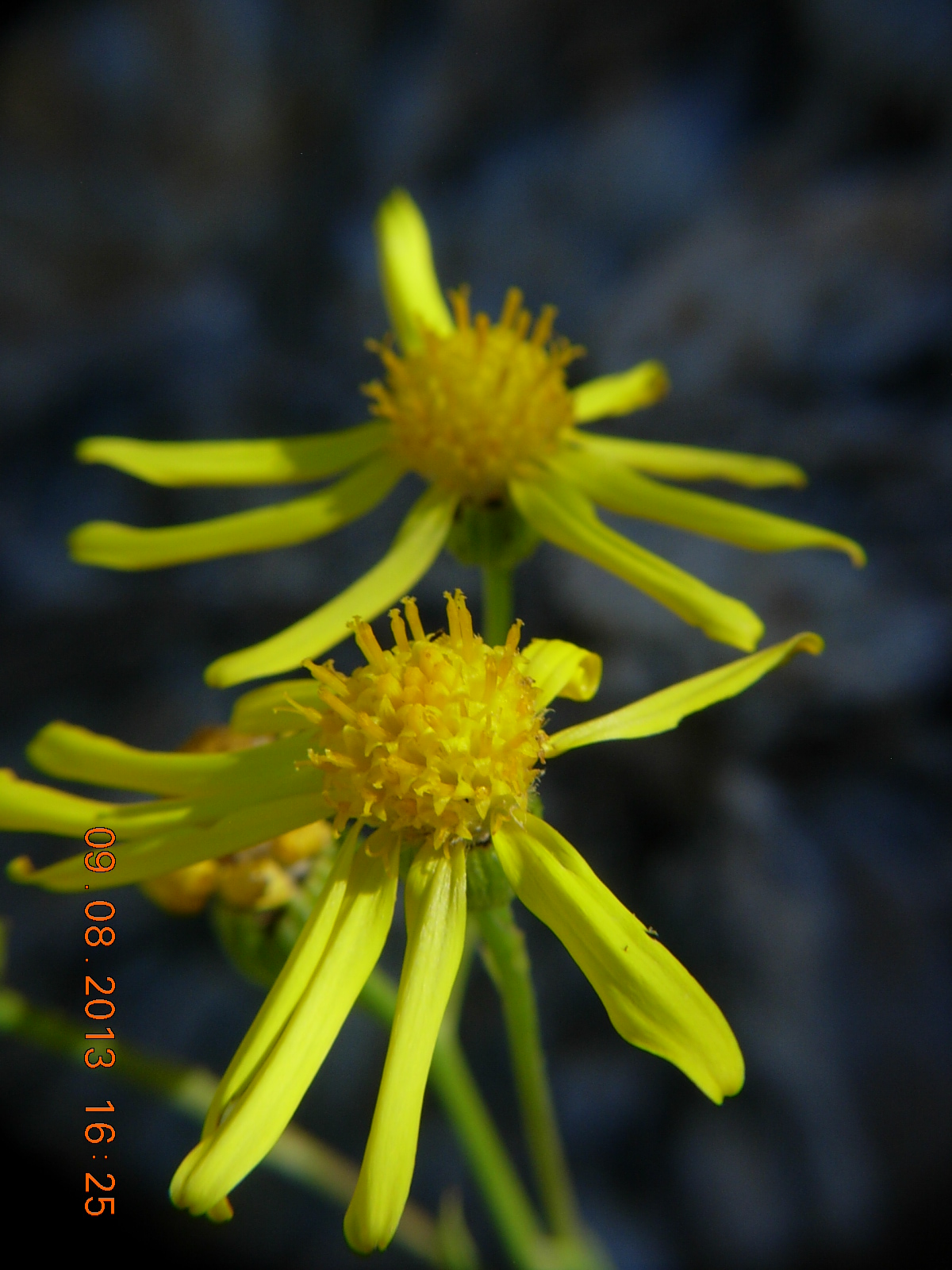
Senecio pyrenaicus subsp. caespitosus

Senecio pyrenaicus subsp. caespitosus
i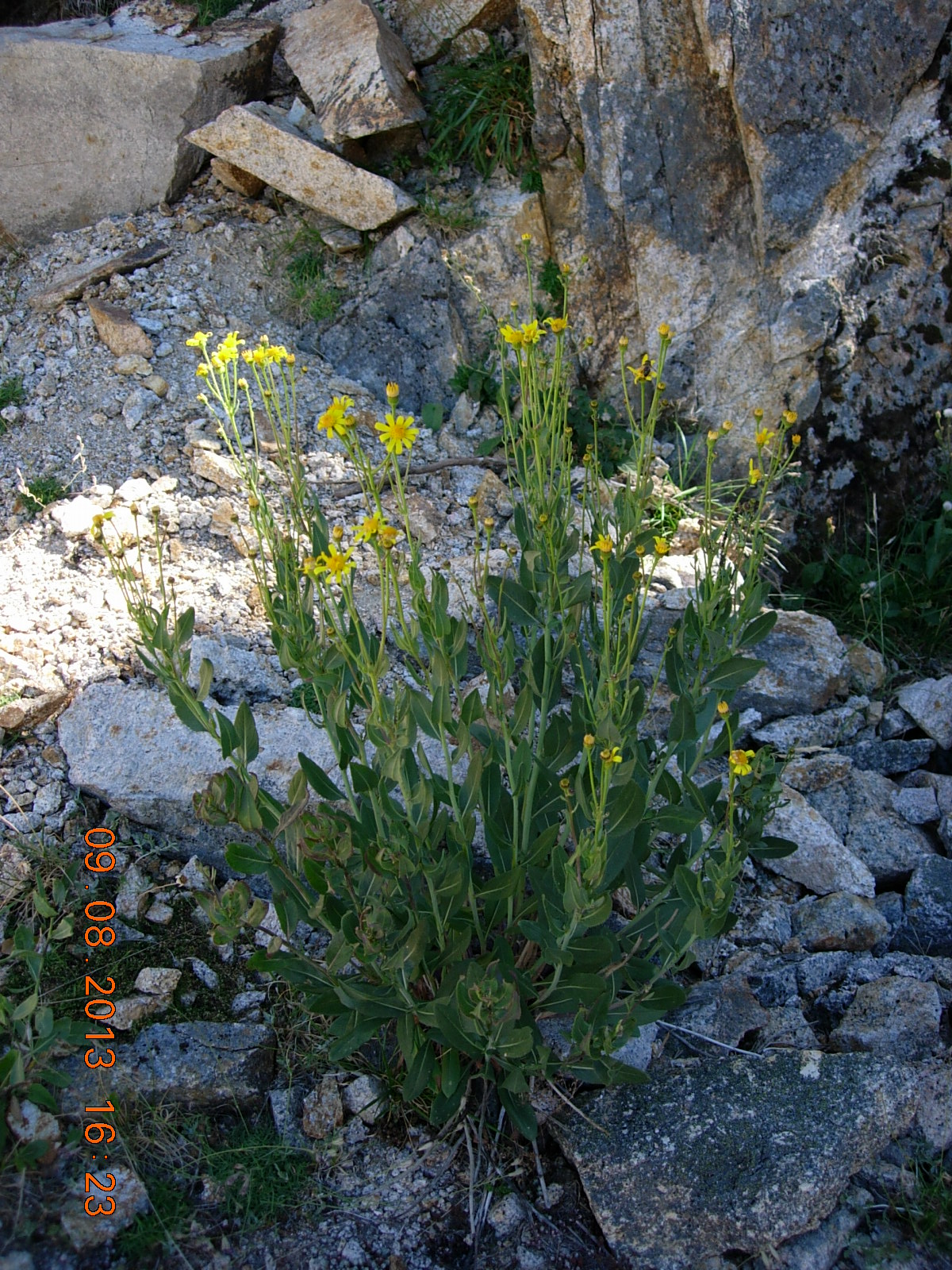
Senecio pyrenaicus subsp. caespitosus
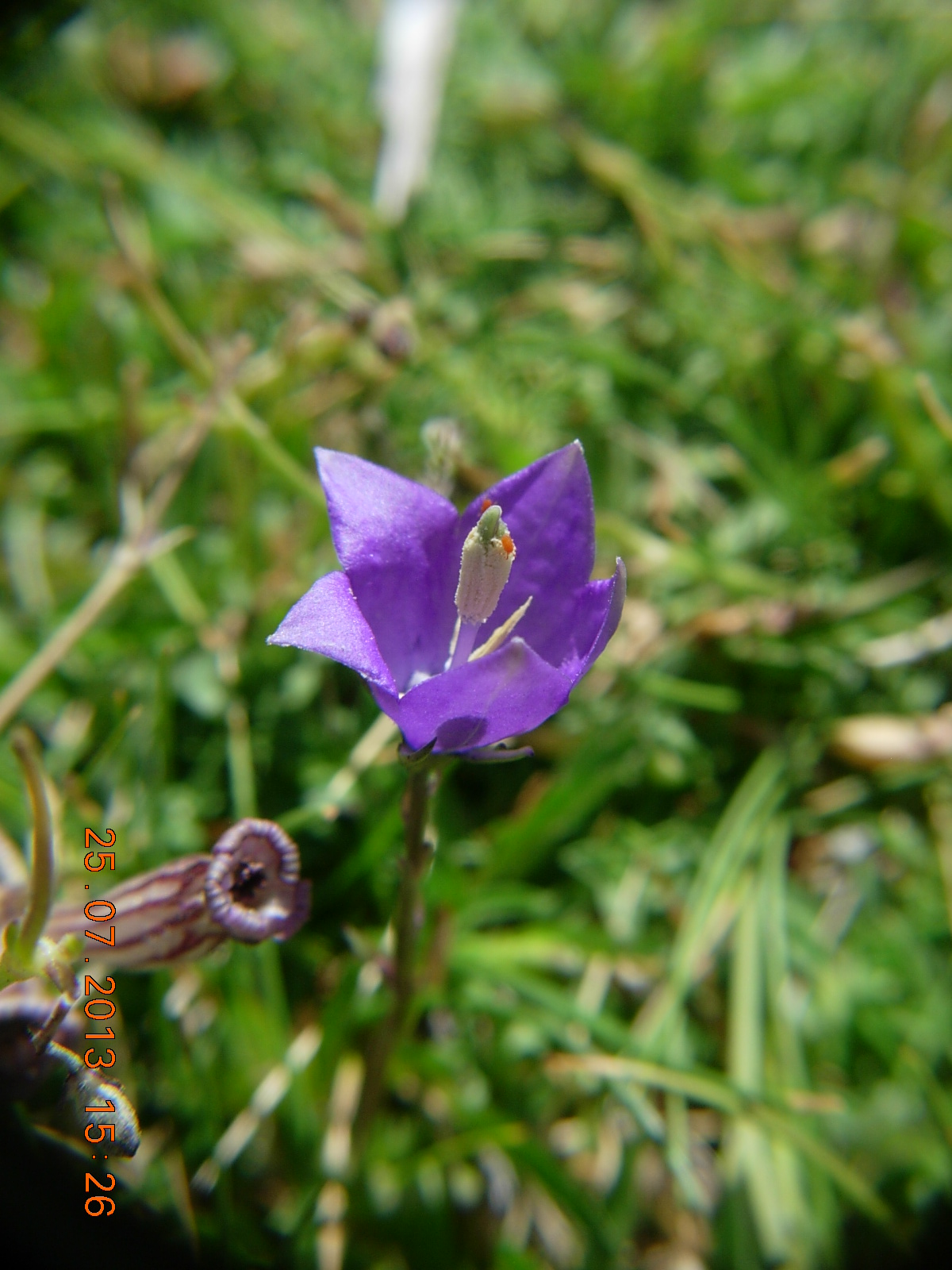
Campanula herminii
Gentiana lutea subsp. aurantiaca
A Gentiana lutea subsp. aurantiaca existe em Portugal apenas no piso alto da Serra da Estrela onde ocorre em pradarias e em ambientes rochosos. São sobretudo os ambientes rochosos e a inacessibilidade dos penedos e cântaros da serra alta que garantem a sobrevivência desta espécie na Serra da Estrela. As raízes da Gentiana lutea são colecionadas devido às propriedades fitoterapeuticas que lhe são atribuidas e é por isso que a sobrevivência de Gentiana lutea na Serra da Estrela está altamente em risco.
Gentiana lutea subsp. aurantiaca
Gentiana lutea subsp. aurantiaca
Jasione spec.
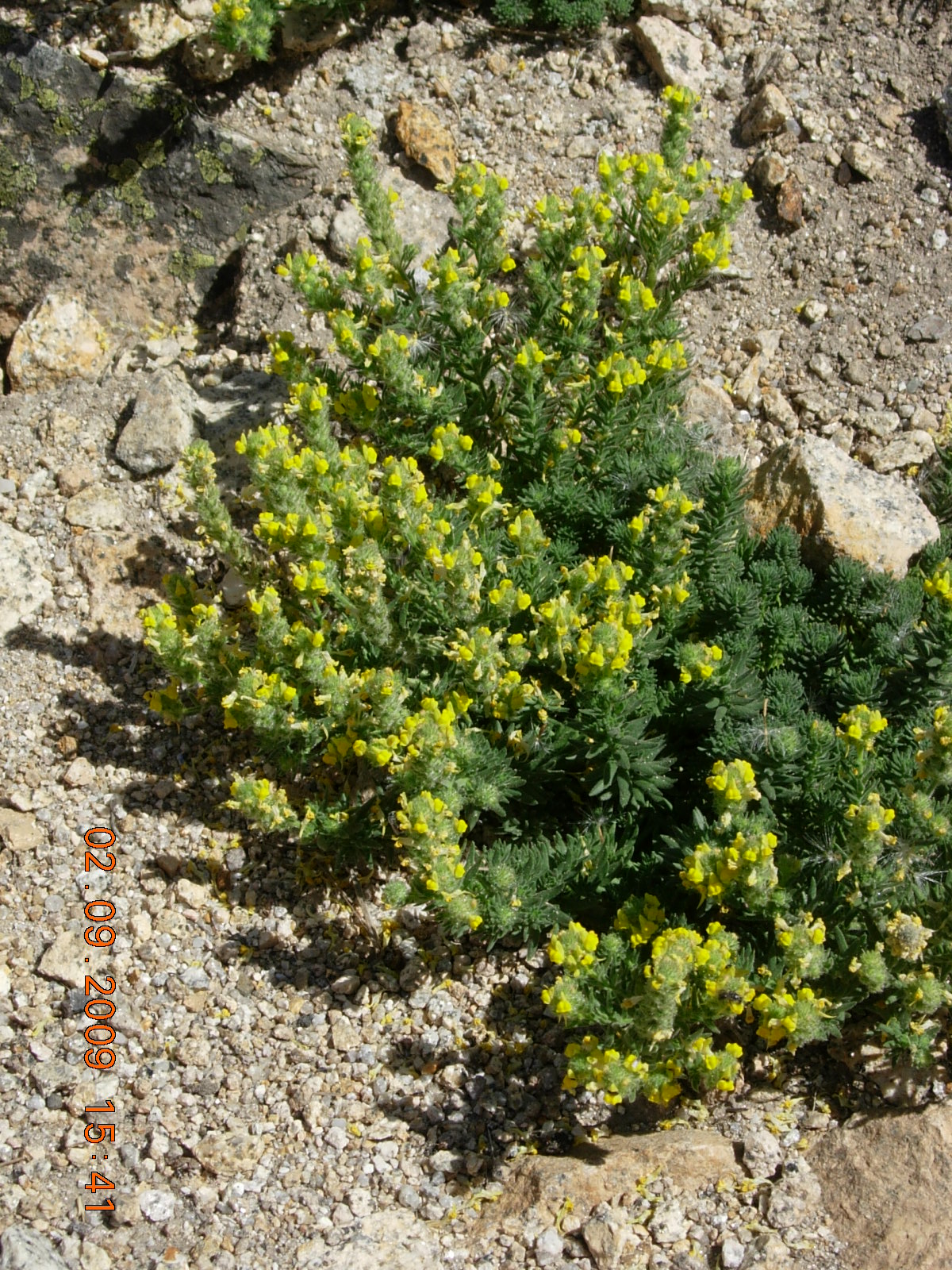
Linaria saxatilis subsp. saxatilis

Linaria saxatilis subsp. saxatilis
Linaria saxatilis subsp. saxatilis
Silene foetida subsp. foetida
.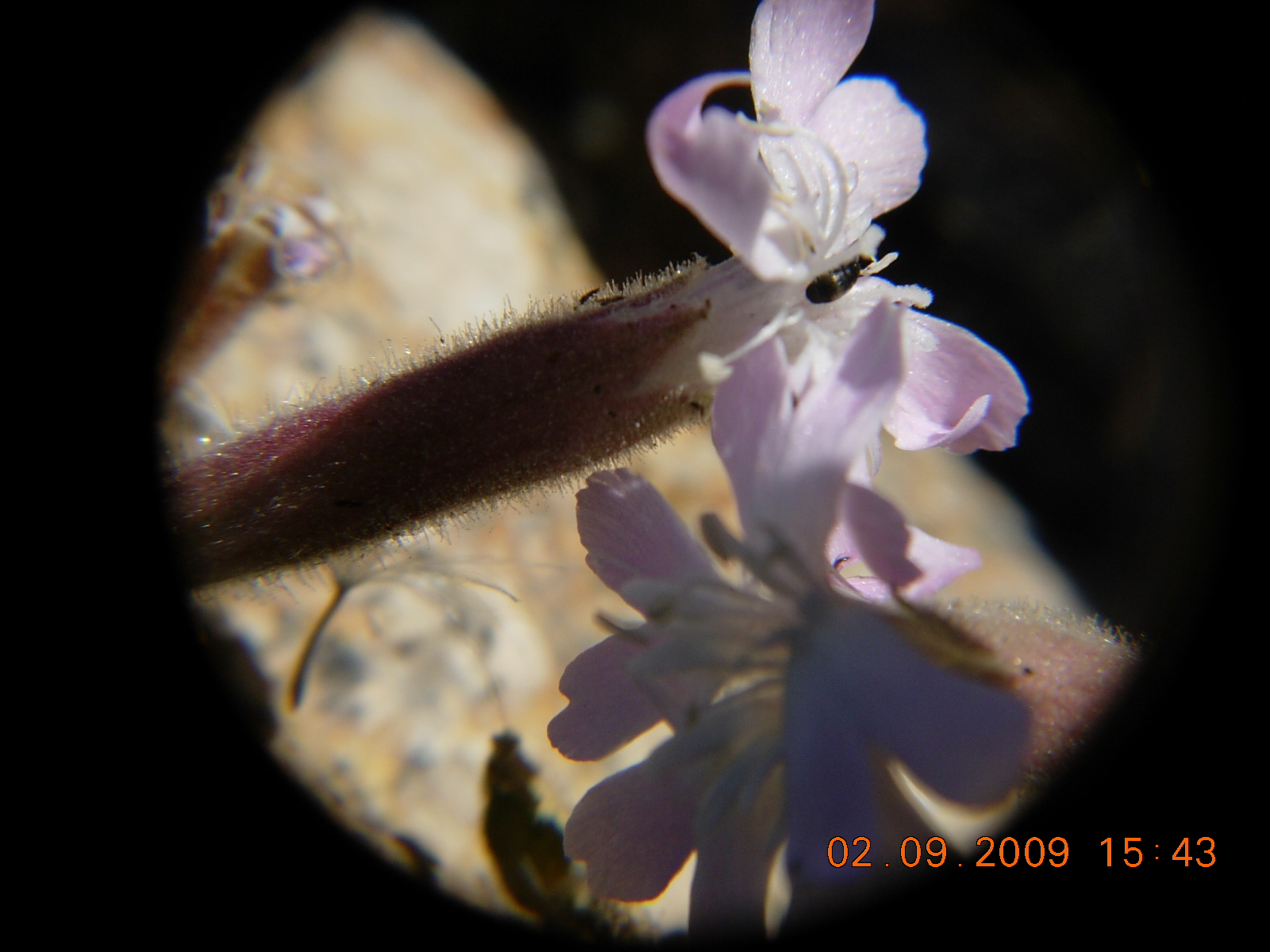
.
Silene foetida subsp. foetida
Silene foetida subsp. foetida
?Solidago virgaurea subsp. fallit-tirones
?Solidago virgaurea subsp. fallit-tirones
Shaded rock fissures in the upper belt often yield a collection of fleshy rosettes of St. Patrick's cabbage (Saxifraga spathularis} . This species is most common in the upper belt, but at lower elevations it can also occur in Birch forests and near to springs. St. Patrick's cabbage prefers rather humid fissures. It is often joined by Murbeckiel!a boryi, although the latter tends to occur more frequently in drier cracks and fissures. Only a few shaded sites have the rare Alchemilla transiens, a perennial of the Rose family with dense clusters of tiny greenish-yellow flowers. In wider soil-filled rock crevices at shaded sites aforementioned species are joined or replaced by components of Festuca henriquesii grasslands or under more exposed conditions by allies of xerophytic perennial grasslands.
Especially overhanging granite rocks may hide ferns like Black spleenwort (Asplenium adiantum-nigrum), Maidenhair spleenwort (Asplenium trichomanes subsp. quadrivalens); Hard fern (Blechnum spicant), and Forked spleenwort (Asplenium septentrionale). The latter occurs in large parts of the northern hemisphere, but is rare in Portugal and outside Estrela only known from a few sites around Braganca and Vinhais . Other ferns at high elevations include Parsley fern (Cryptogramma crispa) and Mountain male fern (Dryopteris oreades). They may he found colonizing the cracks and fissures of rock faces, but there is a better chance to find them between large boulders in screes.
2. Seixos na zona (piso) de Alta Altitude (oro-temperada) (Habitat 8130)
Caracterização
• Cascalheiras graníticas supratemperadas a orotemperadas de corologia estrelense.
• As plantas vasculares mais frequentes nestas cascalheiras são perenes, frequentemente estolhosas, rizomatosas ou providas de um sistema radicular longo profundante ou paralelo à superfície do solo. Em termos fitossociológicos são consideradas como características da classe Thlaspietea rotundifolii, e.g.: Arrhenatherum elatius subsp. carpetanus, Coincya monensis subsp. orophila, Digitalis purpurea subsp. carpetana, Doronicum carpetanum, Dryopteris expansa, D. oreades, Eryngium duriaei subsp. duriaei, Lactuca viminea subsp. viminea, Leontodon hispidus subsp. bourgaeanus, Linaria saxatilis subsp. saxatilis, Paronychia polygonifolia, Phalacrocarpum oppositifolium subsp. oppositifolium, Reseda gredensis, Rumex suffruticosus, Scrophularia herminii, Senecio pyrenaicus subsp. caespitosus, Silene foetida subsp. foetida, Solidago virgaurea subsp. fallit-tirones, Trisetaria hispida.
• Nas cascalheiras são ainda frequentes elementos florísticos de cervunal (vd. habitat 6230 “Formações herbáceas de Nardus, ricas em espécies, em substratos siliciosos das zonas montanas (e das zonas submontanas da Europa continental)”) e de prados psicroxerófilos (habitat 6160 “Prados oro-ibéricos de Festuca indigesta”).
• Nas cascalheiras siliciosas orófilas foram identificadas três fitocenoses de Thlaspietea rotundifolii com distintas exigências no que respeita ao abastecimento em água e à mobilidade e dimensão dos fragmentos rochosos.
• Na Serra da Estrela a vegetação de Thlaspietea rotundifolii pode ainda, pontualmente, surgir em moreias e caos de blocos, devendo estes habitates ser também interpretados no âmbito deste subtipo.
Correspondência fitossociológica
• Ordens Androsacetalia alpinae e Polystichetalia lonchitidis (classe Thlaspietea rotundifolii).
Bioindicadores
• Presença em combinações florísticas variáveis de Cryptogramma crispa, Digitalis purpurea subsp. carpetana, Dryopteris oreades, Eryngium duriaei subsp. duriaei, Leontodon hispidus subsp. bourgaeanus, Phalacrocarpum oppositifolium subsp. oppositifolium, Reseda gredensis, Rumex suffruticosus, Scrophularia herminii, Senecio pyrenaicus subsp. caespitosus, Silene foetida subsp. foetida, Trisetaria hispida.
Screes of the upper belt
Dating back to the Ice Ages, steep cirque walls have shed numerous rock particles under the attack of physical weathering processes, particularly frost shattering. Freezing and thawing of melt water in cracks dislodged rock fragments of various sizes. A major part of the material accumulated under the cliffs. The areas with accumulated lumps are called screes. In the Estrela screes carry also lots of other deposits. Due to gravity the particles are usually sorted along the slope, at least where a large range of particle-sizes is available. The larger rocks (boulders) subside to the base of the slope, whereas the tiny grains lodge at the top. Under the present-day conditions in the Estrela frost shattering is of minor importance and most of the screes are clearly inactive, although there is still some local activity due to physical processes like run off, rain-splash and frost-creep. Furthermore, disturbance induced by man or animals can affect the scree surface triggering flows of rubble. Good examples of screes can be found close to the Planalto Superior in the upper reaches of the glacial troughs of the Zezere and the Alforfa.
Planalto com Cântaros e Vales superiores dos Rios Zêzere e Alforfa (Extrato de: Cartas Topographicas de Portugal. 1:25.000)
Glaciação da Serra da Estrela (From: Daveau, S. (1971) )
Zonas da Ribeira de Alforfa onde são indicados depositos mediterrânicos siliciosas orófilas em cascalheiras (engl. screes) - nas zonas de ‘Espinhaço de Cão’ e ‘Cascalvo’. Na imagem satelite visível um enorme campo de ‘Caos de blocos’ (engl. block stream) na encosta oeste do Alto da Pedrice (Imagem satelite from: Google Earth).

Vista para o Val do Rio Alforfa (Serra da Estrela). Ao fundo as cascalheiras do Alto da Pedrice. Em frente a Barragem do Covão de Ferro.
Vista em direcção do ‘Espinhaço de Cão’ (Serra da Estrela)
Vista em direcção do ‘Alto da Torre’ (Serra da Estrela)
Vista para o Val do Rio Alforfa (Serra da Estrela)
Cântaro Gordo - face sul do Cântaro Gordo (Serra da Estrela).
(a seta branca indica a presença de uma cascalheira (engl. scree)
Lagoa dos Cântaros e face Norte do Cântaro Gordo (Imagem satelite from: Google Earth)
(Na face norte encontra-se a rara associação do Cryptogrammo-Dryopteridetum com Cryptogramma crispa.)
Covão do Cântaro e Lagoa dos Cântaros (Serra da Estrela)
Zona de ‘Penha do Gato’ onde também são indicados depósitos mediterrânicos siliciosas orófilas em cascalheiras (engl. screes). (Imagem satelite from: Google Earth).
Most of the screes are moderately to strongly inclined, mainly having north to eastern exposures. They are often situated between steep rock walls that largely prevent sunshine; therefore they permit the persevering of snow cover. The topography favours snow accumulation as heavy winds blow snow over the planes into the lee side where the screes occur. Snow-cover gives protection from the cold, from early sprouting, and from drought. In addition both snow cover and snow melt make soil humidity increase. Climate change (in particular the changes in snow fall and frost action) may affect these biotopes substantially. (Conditions in screes are extreme for plants. Moving individual rock particles or the sliding of the whole slope may injure the root systems of plants or bury them. The quasi-absence of fine earth in the upper slope layer give seeds very few opportunities to germinate. Various growth forms occur, but in general scree specialists have long vertical and/or horizontal roots to cope with the sliding materials. A crisscross pattern of fine roots enables them to take up water and nutrients. Most of the plants make stolons and creeping rhizomes. According to Schröter (1926) five basic growth forms can be distinguished: 1. Schuttwanderer ( 'talus strollers' ), 2. Schuttüberkriecher (‘talus creepers’), 3. Schuttstrecker (‘talus stretchers’), 4. Schuttdecker (‘talus coverers’), 5. Schuttstauer (‘talus pushers’). Some plants may have intermediate traits.
Once some pioneers have settled, they may accumulate organic material and humus. If there is not much additional delivery of debris, the vegetation may extend and further develop into grass land or scrub. In general these processes take thousands of years. Large block streams are hardly colonized because there is no fine material to root in. A good example is the huge block stream on the western slope of the Alto da Pedrice (veja na imagem panorâmica acima)
Some scree specialists occur in secondary biotopes with high disturbance, like burnt areas, road-cuts, artificial exposures and quarries. In the higher zones of the Serra da Estrela at least twenty plant species characteristic of screes can be found (so-called "scree specialists"). Nine of them (marked with *) occur on the preliminary red list of vascular plants in Portugal: with in Portugal thirteen (+) are restricted to the Serra da Estrela; one (# ) is a unique endemic species. Many of these plant species may be of Tertiary origin.
The following species are characteristic:
Coincya monensis subsp. orophila
| |
Scrophularia herminii
| |
Trisetum hispidum Dominanzgesellschaft
Segundo Jan Jansen (2011) a associação de dominância de Trisetum hispidum fica caracterizada pela dominância de Trisetum hispidum e pela presença regular de Linaria saxatilis. Lactuca viminea e Arrhenaterum cf. carpetanum, duas espécies da Thlaspietia, diferenciam a comunidade em relação às outras desta classe. Tal como no Violetum langeanae aparecem também na comunidade Trisetum hispidum muitas espécies que se encontram nas classes Koelerio-Corynephoretea e Tuberarietea. Não é o número de espécies mas a cobertura total das espécies da Thlaspietea que é maior do que na Koelerio-Corynephoretea- e Tuberarietea. Isto é causado sobretudo pela dominância de Trisetum hispidum. .
(Die Trisetum hispidum-Dominanzgesellschaft wird durch die Dominanz von Trisetum hispidum sowie durch das regelmäßige Auftreten von Linaria saxatilis charakterisiert. Lactuca viminea und Arrhenatherum cf. carpetanum, zwei Thlaspietea-Arten, differenzieren die Gesellschaft gegenüber den anderen dieser Klasse. Einschließlich Coincya orophila gibt es in allen vier Aufnahmen nur fünf Thlaspietea-Arten. Wie im Violetum langeanae treten auch in der Trisetum hispidum-Dominanzgesellschaft viele Arten auf, die in Gesellschaften der Koelerio-Corynephoretea und Tuberarietea verbreitet sind. Nicht die Zahl sondern die Gesamtdeckung der Thlaspietea-Arten ist größer als die der Koelerio-Corynephoretea- und Tuberarietea-Arten. Dies wird insbesondere durch die Dominanz von Trisetum hispidum verursacht.)
Coincya monensis subsp. orophila
|
Três tipos principais de cascalheiras são distinguidos por Jan Jansen (2001) para o piso alto da Serra da Estrela:
2.1 Silene foetida scree vegetation
(Sileno foetidae-Rumicetum suffruticosi (Rivas-Martínez) Jansen ass. nov.)
Silene foetida screes are relatively dry screes consisting: of small to medium sized, partly consolidated rocks.
Silene foetida subsp. foetida is a strictly endemic taxon of the Serra da Estrela. Silene foetida subsp. gayana is a related taxon endemic to NW-Spain, colonizing screes as well.
Silene foetida subsp. foetida makes long shoots that lay over the rock debris and then root again ('talus creeper’). In this way it moves passively along the sliding materials. The plant is sticky, raising its capacity to adhere to the rubble. Other species typical of this environment are Eryngium duriaei subsp. duriaei.
Phalacrocarpum oppositifolium, Reseda gredensis, and Rumex suffruticosus. All of them are confined to the upper belt except for Phalacrocarpum oppositifolium. This pretty Daisy grows also in rock fissures and talus slopes of the middle belt. Its range includes more or less the north-western quadrant of the Iberian Peninsula. Rumex suffruticosus is an Iberian endemic often growing with Trisetaria hispida in the mountains of north-west Spain. This is not the case in the Estrela. Here the latter seems to prefer the dynamics of burnt areas. sometimes dominating post-fire vegetation on slopes in the upper reaches of the Zezere valley. The growth strategy of Eryngium duriaei subsp. duriaei is different from that of Silene foetida. It has a long and thick rootstock that grows as an anchor deep into the scree, holding up the moving materials ('talus stretcher'), Reseda gredensis is extremely rare, being represented by an assumed population of less than hundred specimens. It is an endemic species only known from Estrela and Gredos mountains. Silene foetida screes may grade into open xerophytic summit grasslands in areas where there is more accumulation of gravel and other fine material.
As seguintes espécies são características para esta associação:
2.2 Leontodon bourgaeanus scree vegetation
(Digitali carpetanae-Leontodontetum bourgaeani ass. nov. hoc loco)
Vegetation with Leontodon hispidus subsp. bourgaeanus inhabits screes that receive extra irrigation including dissolved nutrients from the pastures of the Planalto Superior. The screes in question may partly function as temporal stream beds transporting melt and rain water.
Individual plants of Leontodon bourgaeanus are frequently interwoven forming small mats (‘talus coverer') . These are often joined by Digitalis purpurea subsp. carpetana and Mountain male fern (Dryopteris oreades). In such a humid environment tall forbs may thrive like Scrophularia herminii, Angelica major, and Crepis lampsanoides, especially at sites sheltered from heavy winds and long periods of sunshine. Doronicum carpetanum must have grown in this biotope too. It seems however that this tall forb species has become extinct by now. The related Doronicum pubescens and Doronicum plantagineum do not occur in the same biotope. The former has been recently described and reported new to the flora, occurring in the Serra de Montesinho and in north-west Spain. So far in the Estrela it has been found only once. It occurred in Genista florida scrub situated in the Mondego basin. Under similar growth conditions it may also be expect ed in Birch woods. Doronicum plantagineum can he observed in stands of the Pyrenean oak along the road to Poço do Inferno.
In less dynamic areas, often close to outcrops or at gently sloped sites Leontodon bourgaeanus scree vegetation may grade into Festuca henriquesii grasslands.
As seguintes espécies são características para esta associação:
Scrophularia herminii
|
2.3 Cryptogramma crispa scree vegetation
(Cryptogrammo crispae-Dryopteridetum oreadis Rivas-Martínez in Rivas-Martínez & Costa 1970)
This type of vegetation is very rare, inhabiting small sites in more or less consolidated screes consisting of medium to large-sized rocks. Parsley fern (Cryptogramma crispa) is a glacial relict known from Europe and western Asia. In the Estrela it prefers shady conditions mostly found near large boulders. It is assumed that the species is largely dependent on the protection that snow cover provides against frost. Vegetation with Parsley fern hosts interesting bryophytes, some of which are glacial relicts too. The most common fern species in this environment is the conspicuously tufted Mountain male fern and so, from a distance , it is difficult to distinguish the Cryptogramma crispa from the Leontodon bourgaeanus vegetation type. Only from nearby one may observe the small Parsley fern and some of the finest bryophytes. Cryptogramma crispa scree vegetation is usually much better developed in the higher Iberian mountains that like Estrela have been glaciated during the penultimate glaciation. Leontodon bourgaeanus vegetation on the other hand seems to be best developed in Estrela. This is probably related to the irregularity of both snow fall and snow cover in the Estrela. Northern buckler fern (Dryopteris expansa) is perhaps even more rare than Parsley fern. In exceptional cases they may grow together. However, Northern buckler fern is also found growing in and near Saxifraga stellans springs. With in Portugal Parsley fern and Northern buckler fern are restricted to the upper belt of the Serra da Estrela; Mountain male fern also occurs in the higher parts of the Serra do Geres.
As seguintes espécies são características para esta associação:
Jan Jansen (2001) encontrou esta associação rara quase apenas em circos (deutsch - Kare) na face norte do Cântaro Gordo, onde começou antigamente o glaciar de Candieira. Estes sítios s-ao no inverno relativamente bem protegidos do frio porque estão cobertos com neve. Festuca henriquesii (observações de Jan Jansen) e Kiaeria starkei (Frey et. al. 1995) podem servir de indicadores de neve.
(Ich habe das Cryptogrammo-Dryopteridetum fast nur in Karen nördlich des Cântaro Gordos gefunden, wo einst der Candieiragletscher wurzelte. Diese Stellen sind im Winter relativ gut gegen Kälte geschützt, weil sie dann oft von Schnee bedeckt sind. Festuca henriquesii (eigene Beobachtungen) und Kiaeria starkei (Frey et al. 1995) können als Schneezeiger gelten. Auch diese Gesellschaft zeigt ihr phänologisches Optimum auf Grund der langen Schneebedeckung erst im Spätsommer (August).) (Jan Jansen, 2001)
A presença da espécie rara de feto Dryopteris expansa na Serra da Estrela está documentado por Rivas-Martínez et. al. (1989, Tabla 3).
(In der synoptischen Tabelle von Rivas-Martínez et al. (1989, Tabla 3) kommt die seltene Art Dryopteris expansa nur in Aufnahmen aus der Serra da Estrela vor. Ich habe den Farn nur in oder in der Nähe von Quellen angetroffen. Die Art scheint in der Estrela also nicht auf Schutthalden beschränkt zu sein. Im Cryptogrammo-Dryopteridetum selbst habe ich diese Art nie beobachtet.) (J. Jansen, 2001)
Kiaeria starkei (Bryophyta)
Parsley fern (Cryptogramma crispa)
|
Northern buckler fern (Dryopteris expansa)
|
3. Cavernas
Caves
Caves and former mines are very important habitats for bats of which as much as 19 species occur within the limits of the Park.
These environments are also of botanical interest, hosting ferns and bryophytes. The present fern species are known from other vegetation types and are left without consideration here. One conspicuous bryophyte is singled out, namely Schistostega pennata. This moss appears luminescent, caused by the light-refractive properties of the protonema, a basic structure in the life-cycle of bryophytes. Schistostega pennata forms bluish-green patches in dark places such as entrances to caves, old mines, and rocks excavated by shepherds for use as shelters.
Schistostega pennata
|
Anexos
1 Tabelas fitossociológicas
Chapter 5, Table 1: Übersicht der Thlaspietea-Gesellschaften in den höheren Stufen der Serra da Estrela
|
Uma tabela sinóptica da vegetação das Classes … da Serra da Estrela encontra-se em Jan Jansen (2011): Managing Natura 2000 in a changing world: - Radboud Universiteit - Anexos - (Chapter 5, Table 2 ….. Destacado em amarelo: Lichens e Musgos - alteração da tabela original).
Chapter 5, Table 2 Violetum langeanae Ortiz & Samaniego 1989
|
2 Associações fitossociológicas
(As associações fitossociológicas presentes em ambientes rochosos da Serra da Estrela foram identificadas por: Jan Jansen (2002): Geobotanical guide of the Serra da Estrela. Instituto da Conservação da Natureza. Ministério das Cidades, Ordenamento do Território e Ambiente, Lisboa.
As descrições das classes fitossociógicas são as descrições das respectivas classes fitossóciológicas em: Rivas-Martínez et. al. (2002): Vascular Plant Communities of Spain and Portugal. Addenda to the Syntaxonomical Checklist of 2001. ITINERA GEOBOTANICA. Vol. 15(1).)
(From: Jan Jansen (2002) :Geobotanical guide of the Serra da Estrela. Instituto da Conservação da Natureza. Ministério das Cidades, Ordenamento do Território e Ambiente, Lisboa.)
Locais pontuais na cintura oromediterrânea, entre o C. raso e o C. Gordo e a Este do Alto da Torre. (Cryptogrammo; Phalacrocarpo). Na cintura supra- e mesomediterrânea no Souto do Concelho (Rumex induratus). Na cintura oromediterrânea e supramediterrânea nos deslizamentos de cascalho, à volta da Penha do Gato, Espinhanço do Cão e Cascalvo (Violetum langeanae). Ainda a SE de Piornos vegetação dominada por Trisetum hispidum.
Classe THLASPIETEA ROTUNDIFOLII Br.-Bl. 1948
Loose shifting scree, stone and pebble perennial communities of mountain slopes, moraines and riverine gravel deposits, growing on boreal, temperate and mediterranean bioclimates in the Holarctic territories.
Temperate and Mediterranean high calcareous mountains, calc-schist or calcium carbonate rich shifting stones (Thlaspietalia rotundifolii) [oro-cryorotemperate Pyrenean (Iberidion spathulatae), oro-cryorotemperate Orocantabric (Linarion filicaulis), Pyrenean and Orocantabric wet and long snow covered (Saxifragion praetermissae), supratemperate
Orocantabric and Castilian Cantabrian (Iberido-Linarion propinquae), supraoromediterranean
Betic (Platycapno-Iberidion lagascanae)]; Temperate and Mediterranean high siliceous mountains and lacking calcium carbonate shifting stones (Androsacetalia alpinae) [oro-cryorotemperate Pyrenean (Senecionion leucophylli), meso-supratemperate Pyrenean (Galeopsion pyrenaicae), Carpetan, Bercian-Sanabriensean, Oroiberian and Orocantabric (Linario saxatilis-Senecionion carpetani), Nevadensian oro-cryoromediterranean (Holcion caespitosi)]; boreal, temperate and mediterranean high mountain deposits of blocks by periglacial congelifraction, glacial erratic, etc., rich in ferns (Polystichetalia lonchitidis) [rich in calcium carbonate (Gymnocarpion robertiani), lacking calcium carbonate (Dryopteridion oreadis)]; thermo to supramediterranean dry and subhumid gravel, pebble and block slopes in Western Mediterranean (Andryaletalia ragusinae) [riverine deposits (Glaucion flavi), Setabensean and Valencian shifting stones and blocks (Scrophularion sciophilae)]; supra and lower orotemperate and submediterranean Alpine, Middle European, Pyrenean, Orocantabric and Oroiberian calcareous or calcium carbonate rich loose scree and riverine gravel deposits (Achnatheretalia calamagrostis) [loose shifting stones (Achnatherion calamagrostis), Pyrenean, Orocantabric and Oroiberian riverine (Calamagrostion pseudophragmitis)]; upper cryorotemperate early snow-free on poor, neutral or rich screes or congelifracted slopes of Alpine and Pyrenean high mountains (Drabetalia hoppeanae) [Pyrenean nival summits (Androsacion ciliatae)]. European Holarctic.
(From: Rivas-Martínez et. al. (2002): Vascular Plant Communities of Spain and Portugal. Addenda to the Syntaxonomical Checklist of 2001. ITINERA GEOBOTANICA. Vol. 15(1).)
|
Veja à seguir: 13. The Northern Serras of Portugal (Serra da Estrela - Ambientes rurais)
Home (Index (Goggle Docs - Blogger))

Sem comentários:
Enviar um comentário